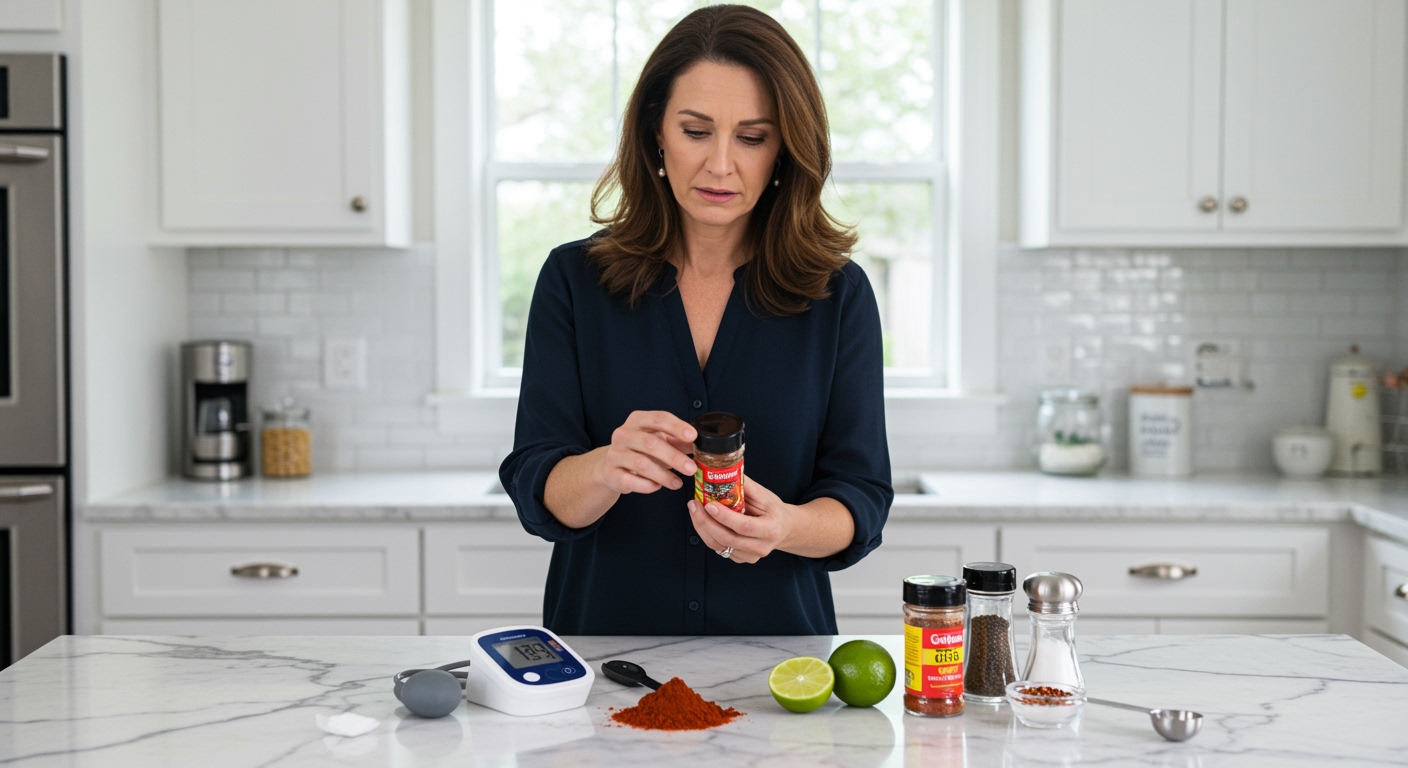✪ Key Takeaway: Tajin contains high sodium levels that can raise blood pressure, but occasional use in small amounts is manageable for most people.
Introduction
Your favorite Mexican seasoning might be secretly working against your heart health goals.
You probably reach for that bright red bottle of Tajin without thinking twice about what it does to your blood pressure numbers.
Hi, I’m Abdur, your nutrition coach and today I’m going to explain exactly how Tajin affects your blood pressure and what you can do about it.
What Makes Tajin a Blood Pressure Concern?
Tajin contains sodium as its primary ingredient after chili peppers and lime.
One teaspoon of regular Tajin delivers about 190 milligrams of sodium, which represents roughly 8% of your daily recommended limit.
Your kidneys work hard to balance sodium levels in your bloodstream.
When you consume too much sodium, your kidneys hold onto extra water to dilute the sodium concentration.
This extra water increases your blood volume, which forces your heart to pump harder and raises your blood pressure.
The American Heart Association recommends limiting sodium intake to 2,300 milligrams daily, with an ideal target of 1,500 milligrams for people with high blood pressure.
✪ Fact: Most Americans consume over 3,400 milligrams of sodium daily, nearly double the recommended amount.
How Much Tajin Actually Affects Your Numbers?
The impact depends entirely on how much you use and how often you reach for that bottle.
A light sprinkle on your fruit uses about quarter teaspoon, delivering roughly 50 milligrams of sodium.
Heavy seasoning on a large meal can easily add up to two teaspoons, contributing 380 milligrams of sodium to your daily total.
Your blood pressure response to sodium varies based on your individual salt sensitivity.
Some people experience significant blood pressure spikes from moderate sodium intake, while others show minimal response.
Research shows that people with existing high blood pressure, diabetes, or kidney disease tend to be more sodium sensitive than healthy individuals.
✪ Pro Tip: Track your blood pressure for a week while using Tajin normally, then avoid it for a week to see your personal response.
Does Low Sodium Tajin Solve the Problem?
Tajin offers a low sodium version that contains about 120 milligrams per teaspoon instead of 190.
This 37% reduction makes a meaningful difference if you use Tajin frequently throughout the day.
However, the low sodium version still contributes significant sodium to your daily intake, especially with generous portions.
The taste profile changes slightly because sodium enhances flavor perception in ways that other ingredients cannot fully replace.
Many people find themselves using more of the low sodium version to achieve the same flavor satisfaction.
This behavior can actually result in similar or even higher total sodium consumption than using the regular version sparingly.
✪ Note: Low sodium versions work best when you maintain the same portion sizes as the regular product.
What About the Beneficial Ingredients in Tajin?
Tajin contains chili peppers and lime, both of which offer potential cardiovascular benefits.
Capsaicin from chili peppers may help lower blood pressure by promoting vasodilation, which relaxes blood vessel walls.
Some studies suggest that regular capsaicin consumption supports healthy blood flow and may reduce inflammation in blood vessels.
Lime provides vitamin C and citrus flavonoids that support overall cardiovascular health.
However, the amounts of these beneficial compounds in typical Tajin servings are relatively small compared to eating whole chili peppers or fresh lime.
The sodium content likely outweighs any potential benefits from the chili and lime components for people with blood pressure concerns.
✪ Fact: You would need to consume large amounts of Tajin to get meaningful doses of capsaicin, which would deliver excessive sodium.
How Can You Enjoy Tajin Without Harming Your Blood Pressure?
Smart portion control makes the biggest difference in managing Tajin’s impact on your blood pressure.
Use a measuring spoon instead of shaking freely to control exactly how much you consume.
Limit yourself to no more than half a teaspoon per day, which provides about 95 milligrams of sodium from regular Tajin.
Balance your Tajin use by reducing sodium from other sources throughout the day, such as processed foods, restaurant meals, or added table salt.
Consider making your own Tajin-style seasoning using chili powder, lime zest, and just a pinch of salt for better sodium control.
Monitor your blood pressure regularly if you have existing cardiovascular concerns and notice any patterns related to your seasoning habits.
Remember that your total daily sodium intake matters more than any single food item, so focus on your overall eating pattern rather than eliminating Tajin completely.
✪ Pro Tip: Mix Tajin with other sodium-free spices like paprika or garlic powder to stretch the flavor while reducing sodium per serving.
The Bottom Line
Tajin can fit into a blood pressure friendly diet when used mindfully and in moderation.
Small amounts of high sodium foods are better than large amounts of low sodium foods when it comes to managing your overall intake.
I would love to hear about your experience with Tajin and blood pressure management, so please share your thoughts or questions in the comments below.
References
At NutritionCrown, we use quality and credible sources to ensure our content is accurate and trustworthy. Below are the sources referenced in creating this article:
- Is It Bad For You: Is Tajin Seasoning Bad for You
- Tajin Official: Tajin Clasico Seasoning Reduced Sodium
- Bourbono: Is Tajin Bad for You
- Tajin US: Tajin Clasico Low Sodium





